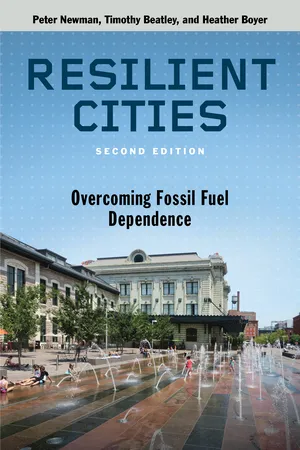
eBook - ePub
Resilient Cities, Second Edition
Overcoming Fossil Fuel Dependence
- 220 pages
- English
- ePUB (mobile friendly)
- Available on iOS & Android
eBook - ePub
Resilient Cities, Second Edition
Overcoming Fossil Fuel Dependence
About this book
What does it mean to be a resilient city in the age of a changing climate and growing inequity? As urban populations grow, how do we create efficient transportation systems, access to healthy green space, and lower-carbon buildings for all citizens?
Peter Newman, Timothy Beatley, and Heather Boyer respond to these questions in the revised and updated edition of Resilient Cities. Since the first edition was published in 2009, interest in resilience has surged, in part due to increasingly frequent and deadly natural disasters, and in part due to the contribution of our cities to climate change. The number of new initiatives and approaches from citizens and all levels of government show the promise as well as the challenges of creating cities that are truly resilient.
The authors' hopeful approach to creating cities that are not only resilient, but striving to become regenerative, is now organized around their characteristics of a resilient city. A resilient city is one that uses renewable and distributed energy; has an efficient and regenerative metabolism; offers inclusive and healthy places; fosters biophilic and naturally adaptive systems; is invested in disaster preparedness; and is designed around efficient urban fabrics that allow for sustainable mobility.
Resilient Cities, Second Edition reveals how the resilient city characteristics have been achieved in communities around the globe. The authors offer stories, insights, and inspiration for urban planners, policymakers, and professionals interested in creating more sustainable, equitable, and, eventually, regenerative cities. Most importantly, the book is about overcoming fear and generating hope in our cities. Cities will need to claim a different future that helps us regenerate the whole planet–this is the challenge of resilient cities.
Peter Newman, Timothy Beatley, and Heather Boyer respond to these questions in the revised and updated edition of Resilient Cities. Since the first edition was published in 2009, interest in resilience has surged, in part due to increasingly frequent and deadly natural disasters, and in part due to the contribution of our cities to climate change. The number of new initiatives and approaches from citizens and all levels of government show the promise as well as the challenges of creating cities that are truly resilient.
The authors' hopeful approach to creating cities that are not only resilient, but striving to become regenerative, is now organized around their characteristics of a resilient city. A resilient city is one that uses renewable and distributed energy; has an efficient and regenerative metabolism; offers inclusive and healthy places; fosters biophilic and naturally adaptive systems; is invested in disaster preparedness; and is designed around efficient urban fabrics that allow for sustainable mobility.
Resilient Cities, Second Edition reveals how the resilient city characteristics have been achieved in communities around the globe. The authors offer stories, insights, and inspiration for urban planners, policymakers, and professionals interested in creating more sustainable, equitable, and, eventually, regenerative cities. Most importantly, the book is about overcoming fear and generating hope in our cities. Cities will need to claim a different future that helps us regenerate the whole planet–this is the challenge of resilient cities.
Frequently asked questions
Yes, you can cancel anytime from the Subscription tab in your account settings on the Perlego website. Your subscription will stay active until the end of your current billing period. Learn how to cancel your subscription.
At the moment all of our mobile-responsive ePub books are available to download via the app. Most of our PDFs are also available to download and we're working on making the final remaining ones downloadable now. Learn more here.
Perlego offers two plans: Essential and Complete
- Essential is ideal for learners and professionals who enjoy exploring a wide range of subjects. Access the Essential Library with 800,000+ trusted titles and best-sellers across business, personal growth, and the humanities. Includes unlimited reading time and Standard Read Aloud voice.
- Complete: Perfect for advanced learners and researchers needing full, unrestricted access. Unlock 1.4M+ books across hundreds of subjects, including academic and specialized titles. The Complete Plan also includes advanced features like Premium Read Aloud and Research Assistant.
We are an online textbook subscription service, where you can get access to an entire online library for less than the price of a single book per month. With over 1 million books across 1000+ topics, we’ve got you covered! Learn more here.
Look out for the read-aloud symbol on your next book to see if you can listen to it. The read-aloud tool reads text aloud for you, highlighting the text as it is being read. You can pause it, speed it up and slow it down. Learn more here.
Yes! You can use the Perlego app on both iOS or Android devices to read anytime, anywhere — even offline. Perfect for commutes or when you’re on the go.
Please note we cannot support devices running on iOS 13 and Android 7 or earlier. Learn more about using the app.
Please note we cannot support devices running on iOS 13 and Android 7 or earlier. Learn more about using the app.
Yes, you can access Resilient Cities, Second Edition by Peter Newman,Timothy Beatley,Heather Boyer in PDF and/or ePUB format, as well as other popular books in Architecture & Architecture General. We have over one million books available in our catalogue for you to explore.
Information
CHAPTER 1
Invest in Renewable and Distributed Energy
The global shift to renewable energy will fundamentally change the nature of energy economics and trade. Nations [and cities] with abundant low cost renewable energy will be the powerhouses of the renewable energy era and the natural home of energy intensive industry.
In the first edition of this book, we wrote about a group of cities showing how to experiment with solar energy and wind power. They were proudly and bravely stepping into a largely unknown world, passionate about starting a journey that had to be embarked on no matter what it cost. These included Masdar City in the United Arab Emirates; Freiburg and Kronsberg in Germany; Malmö in Sweden; Perth, Adelaide, Melbourne, and Sydney in Australia; Cape Town in South Africa; Daegu in South Korea; Barcelona in Spain; London in the United Kingdom; Toronto in Canada; and Seattle, Chicago, San Francisco, Sacramento, Austin, Atlanta, and Honolulu in the United States. Today most of these cities are ramping up their commitments and countless others are joining them, as doing so is no longer an economic burden but an economic necessity. This chapter is about the rise of renewable energy and how it is providing new opportunities for resilient cities.
The major driving force behind this transition has been investment in renewable energy and distributed energy systems. Bloomberg New Energy Finance (BNEF) has documented this trend toward investment in renewable energy.1 BNEF’s data show that the world’s financiers are investing in renewable energy at twice the rate they are investing in coal- and gas-fired power systems. Many nations are well down the track of providing renewable power to their citizens, driven by a combination of policies, business, and community pressure through their cities. Some cities, such as Vancouver, British Columbia, and Christchurch, New Zealand, and countries such as Norway have had high renewables for decades, given their investments in hydropower. To replace fossil fuels with renewables globally, solar and wind power will be needed, in addition to a few other new kinds of renewables. In particular the rapid growth is in rooftop solar power, which is creating a whole new distributed energy system in our cities with multiple benefits for sustainable and resilient cities.2
Table 1.1: Countries with high renewables transitions.
| Country | Renewables in Power, 2015 | Goal |
Spain | 47% | 70% by 2030 |
Denmark | 40% | 100% by 2035 |
Germany | 32% | 40% by 2020 |
United Kingdom | 24% | 30% by 2020 |
Source: Bloomberg New Energy Finance, 2015
With non-hydro renewables as the guide, Spain, Denmark, Germany, and the United Kingdom appear to be the world leaders in the renewable cities transition, as set out in table 1.1.
As explained in the introduction, Denmark’s growth in wealth decoupled from growth in fossil fuels as the nation struggled to establish this new approach to the economy. In 2015, with its economic growth based on renewables, Denmark was able to produce 40 percent of its power from renewables, and its goal is to reach 100 percent in the power sector by 2035, with 100 percent renewable energy in all sectors by 2050. On one day in July 2015 when the wind was blowing strongly, Denmark produced 116 percent of its power from renewables at peak time and 140 percent during off-peak hours; the excess was shared with Germany and Norway, which have hydroelectric storage that can take excess power.
The European Union has a target of 75 percent renewables across all energy sectors by 2050, with 15 percent by 2020. There is little doubt that the renewables transition is under way in Europe, and it is driving not just the global political agenda but also the global economic agenda there. The decoupling of gross domestic product (GDP) from greenhouse gas (GHG) emissions has been driven mostly by European cities, and this is likely to continue to drive the global agenda to decarbonize our cities and regions.
This chapter will address the following questions:
- What is happening with renewables across the world?
- What will happen to the power grid in cities as they transition to renewables? Will it still be needed if solar and storage become commonplace?
- What will drive industry toward renewables?
- What about city initiatives, buildings, and urban development? How can renewables be incorporated?
What Is Happening with Renewables Across the World?
BNEF has made a detailed assessment of the trends across the world and by region.3 Its assessment is that in the twenty-five years from 2015 to 2040, renewables will become the dominant power source in the world. Wind and solar will account for 64 percent of the new generating capacity, and globally there will be 60 percent zero-carbon power, replacing coal and gas, which will decline from 57 percent to 31 percent. See figure 1.1, which is based on trends under way now and indicates we are likely to reach the target of 80 percent by 2050 for all GHG emissions, though power is in fact likely to be ahead of other sectors.
These goals will be achieved because the cost of solar power will come down by 60 percent and wind power by 41 percent, becoming the cheapest energy options across most of the world. In some places and cities this is already the case. Prices for fossil fuels, especially oil and gas, have been very volatile over the past few decades and investors can now see a more reliable option in renewables, given their price decline certainty, universality, and political compatibility as the world becomes increasingly committed to phasing out fossil fuels.
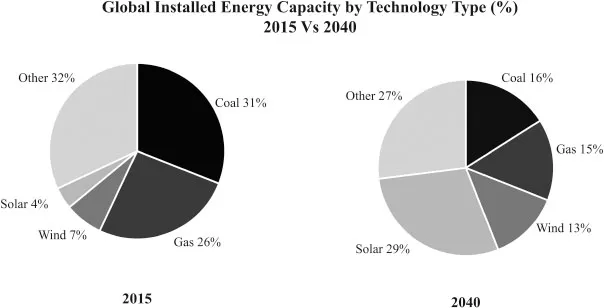
FIGURE 1.1: Global installed energy capacity by technology type, 2015 versus 2040, showing projected growth in renewables at the expense of coal and gas. (Source: Bloomberg New Energy Finance, 2016)
In the United States, wind power supplies approximately 5 percent of the electric power grid. The U.S. Department of Energy reported that by 2050 wind could power approximately 35 percent of the electric grid in the United States (increasing to 10 percent in 2020 and 20 percent in 2030).4 It also reported that wind energy is getting less expensive every year as a result of policy changes and advances in technology: “Since the 1980s, the cost of deploying wind energy has dropped by 90 percent.”5
However, the United States is one place where natural gas is seen by the Bloomberg report to be significantly cheaper than renewables because of cheap fuel (see figure 1.2A–D). Natural gas will likely account for around half of the growth in power investment, given the need to replace aging coal-fired power stations. The other half will more than likely come from small-scale rooftop solar power, which is estimated to increase from 0.8 percent of total installed capacity in 2014 to 40 percent in 2040. As outlined below, the United States has largely been distracted from enabling solar energy as a good business opportunity, as compared with places such as Australia, perhaps because of the political and popular fight between coal and gas, as well as the differences in economic growth between the two places; however, if this changes, the costs of small-scale solar could become cheaper than gas much more quickly.
The big growth in renewables is expected to be in rooftop solar because it fits into a very popular niche and provides new opportunities for consumers (see the Perth example that follows). Thus, the next phase in most cities will be managing the switch to distributed power systems—smaller, localized systems—based on solar or wind energy. For rooftop solar, the cost of battery storage is reducing dramatically.6 This, along with system services such as demand response, control systems, and blockchain software (the software used to enable Bitcoin to be exchanged in a trustworthy way across the Internet), can create “citizen utilities,” as outlined in this chapter.7 Distributed power is the vanguard of innovation in the energy sector and is likely to lead to a renewal of economic activity in those places that can enable it.
The rapid adoption of rooftop solar across the world is what is now called a “disruptive” process that will be driven by cities.8 This is a demand-led process with significant impact on the system within which the innovation happens, in this case the energy grid. Rooftop solar is disruptive because it is being driven by demand and it is disrupting the grid, in no small part due to the continuing decline in the cost of storage batteries as they follow the trajectory of rooftop solar. In Australia in 2016 the price of batteries dropped from A$2,000 per kilowatt-hour (kWh) to A$500, making the solar plus storage option truly competitive in most cities.9 If this use of rooftops for solar power gathers political and popular momentum in the United States, driven by cities with a commitment to decarbonize their future, then it is possible that the growth in natural gas in the United States will be slowed, as is inevitably happening in most of the rest of the world. Without this change from natural gas to solar, U.S. cities will miss out on the many disruptive innovations and opportunities associated with distributed power generation.
Bloomberg expects to see global growth in the use of rooftop solar, particularly in regions such as the Middle East, Africa, and the Asia Pacific. It estimates that between 2015 and 2040, solar photovoltaic (PV) power will account for most of the growth in the power sector, with 3,429 gigawatts (GW) of capacity coming online, around half of it in utility-scale and half in small-scale PV.
Wind and solar capacity are of course variable in their geography, so the story will vary across the planet as to which will be dominant, as shown in figure 1.3. The cost of wind and solar comes down rapidly when they are in good supply.
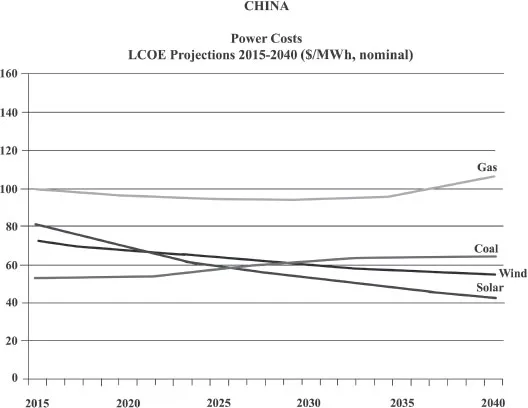
FIGURE 1.2A
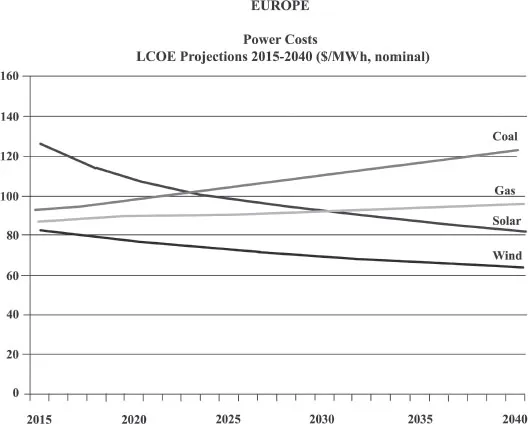
FIGURE 1.2B
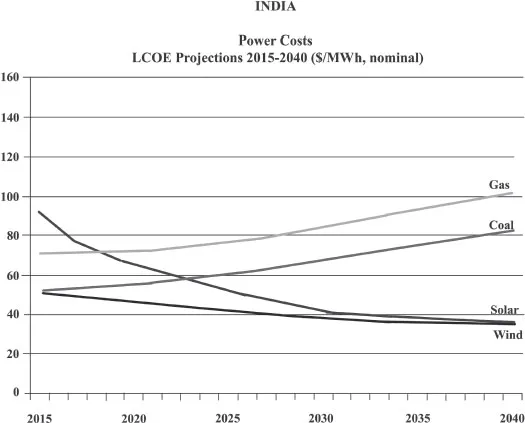
FIGURE 1.2C

FIGURE 1.2D
FIGURE 1.2: Projected costs of power, using levelized cost of electricity (LCOE) in nominal cost per megawatt-hour (MWh), 2015–2040: A, China; B, Europe; C, India; D, United States. (Source: Bloomberg New Energy Finance, 2015)
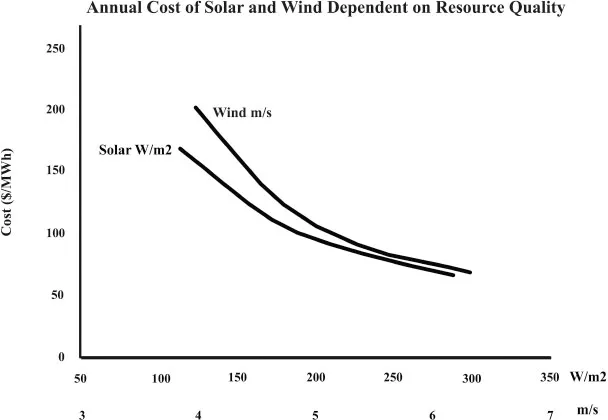
FIGURE 1.3: The annual costs of solar power and wind power depend on the quality of the resource. Here, solar power is measured in watts per square meter (W/m2); wind power, in meters per second (m/s); cost, in dollars per megawatt-hour ($/MWh). (Source: Drew, 2015)
The costs of power options are not just technological costs, however. There is a whole system of costs associated with each type of power source. Figure 1.4 shows that the costs of solar power in Australia are half what they are in the United States, which is why the cities of Australia are now having the highest uptake of rooftop solar in the world. The difference is partly in the cost of panels and inverters, which come mostly from China, but the major difference is in the business costs of permitting, marketing, and financing rooftop solar, which were mainstreamed much more quickly in Australia in the past five years.10
Cities need to capitalize on the new economy that will come from their natural advantages, just as the energy cities of the past were based on coal, oil, and gas resources nearby. Cities can assist this process through setting targets for renewables, creating business opportunities by facilitating establishment of innovative renewables-based companies, reducing the costs of permitting, and enabling residents to invest in renewable energy for their households.
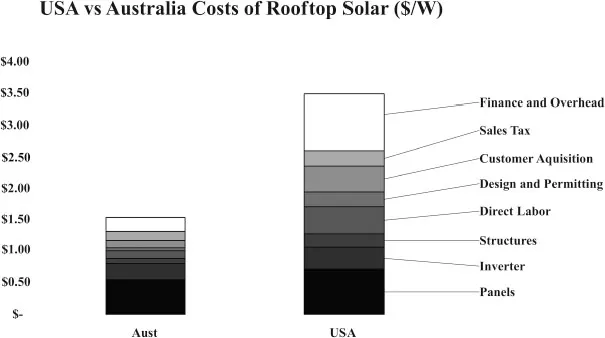
FIGURE 1.4: Installation cost of a 5 kW rooftop solar photovoltaic system, Australia versus United States. (Source: Jarnason, 2016)
The majority of new power will be in the developing world, and it is here that some fossil fuel plants will continue to be built just to keep up with demand for power, using countries’ own fossil fuel resources, as in India and to some extent China. In these emerging nations the ability of solar PV installations to fit into cities is even more obvious, as they can provide immediate power, and with batteries there is potential to leapfrog into the future. Thus it is possible that the emerging cities of the world will proceed faster in the transition to renewables than predicted by Bloomberg.11
Three countries will dominate the new power capacity in Europe between 2015 and 2040, and each country will have a major influence on global trends because of its symbolic and political significance. They are as follows:
- Germany will have the highest renewables power capacity, with 74 percent by 2040. It will be the first country in the Organization for Economic Cooperation and Development to demonstrate how to balance variable energy flows with flexible flows across its network. Battery capacity is likely to grow fastest here.
- France has been the dominant nuclear power nation, with over 50 percent of its power from nuclear energy; but a 19 GW reduction resulting from retirement...
Table of contents
- Cover
- Title Page
- Copyright
- Contents
- Preface
- Acknowledgments
- Introduction: Urban Resilience: Cities of Fear and Hope
- Chapter 1: Invest in Renewable and Distributed Energy
- Chapter 2: Create Sustainable Mobility Systems
- Chapter 3: Foster Inclusive and Healthy Cities
- Chapter 4: Shape Disaster Recovery for the Future
- Chapter 5: Build Biophilic Urbanism in the City and Its Bioregion
- Chapter 6: Produce a More Cyclical and Regenerative Metabolism
- Conclusion: Growing Regeneratively
- Appendix: Metabolism Tables
- Notes
- Bibliography
- Index